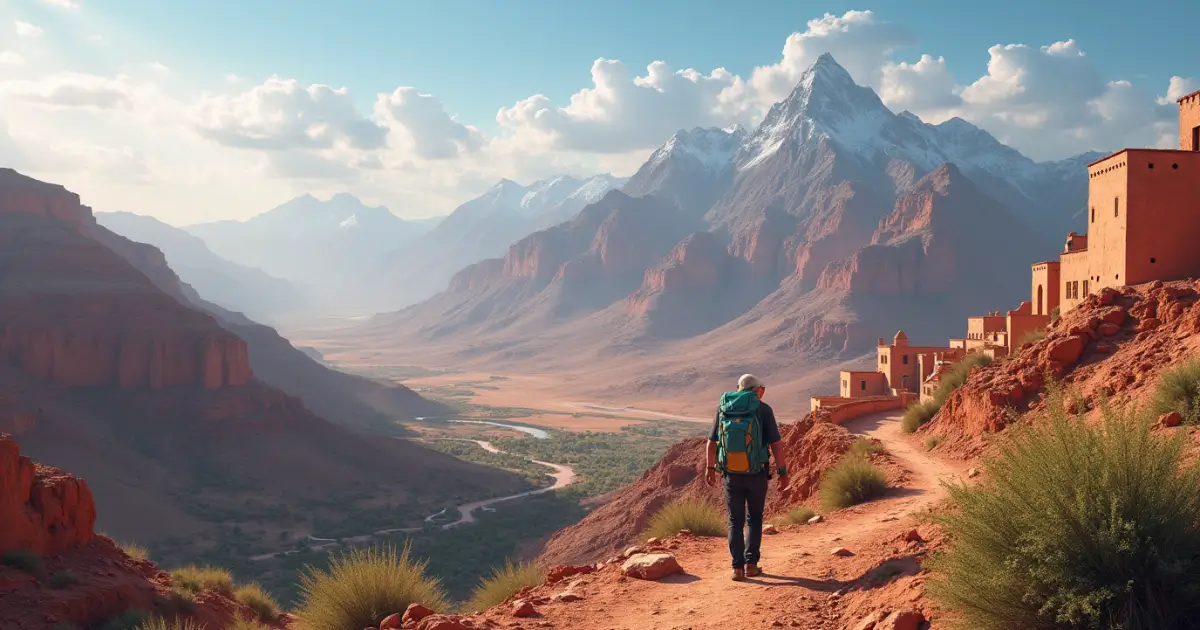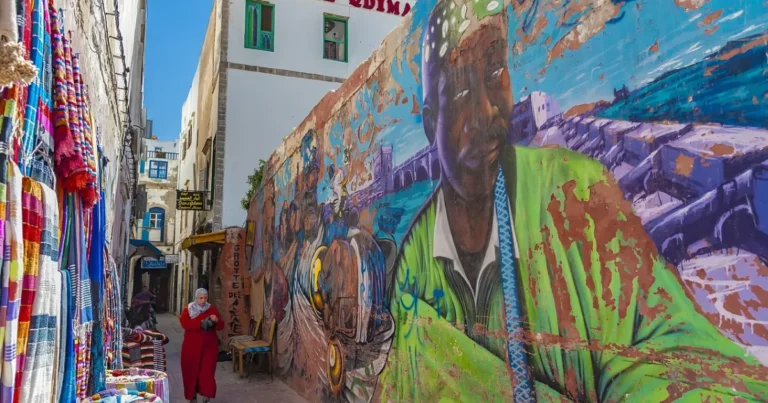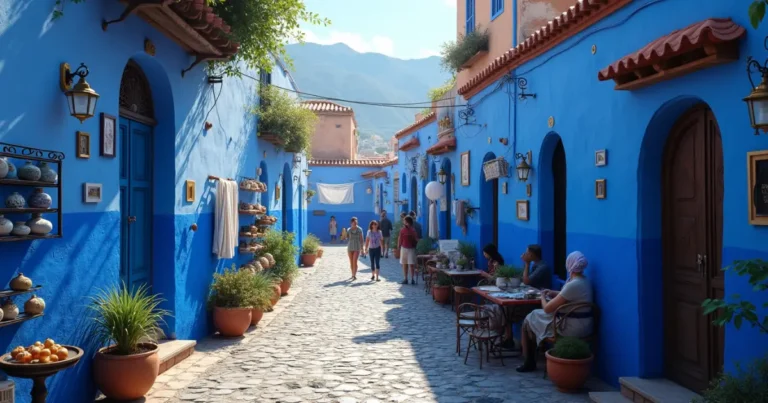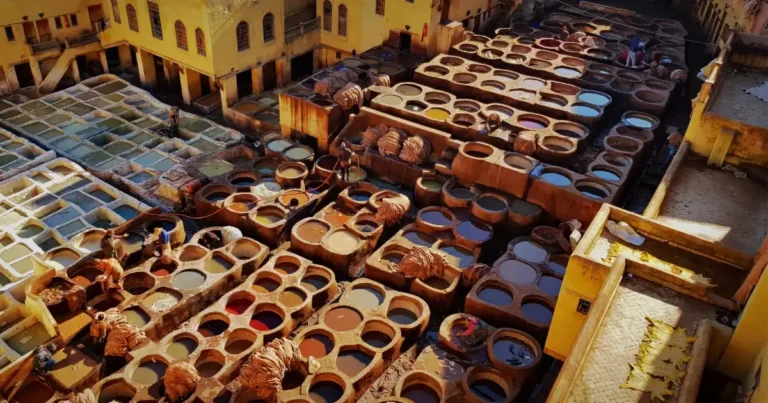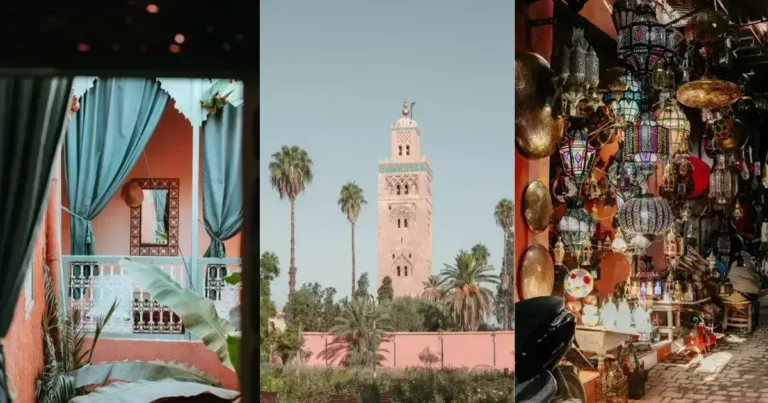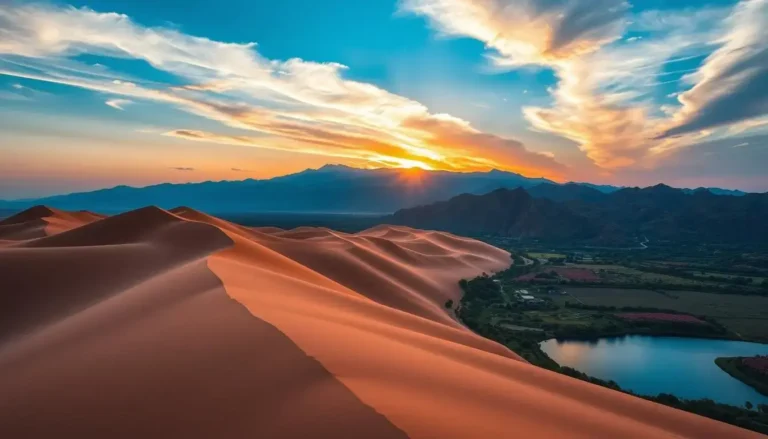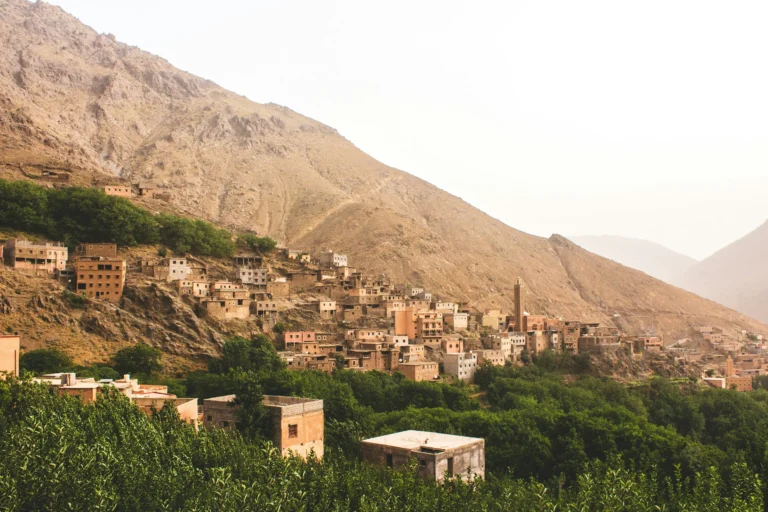The Solo Traveler’s Guide to the Atlas Mountains, Morocco
Are you craving an adventure that combines breathtaking landscapes, rich cultural experiences, and the freedom of solo exploration? Look no further than Morocco’s majestic Atlas Mountains. This comprehensive guide to the Atlas Mountains, Morocco will walk you through everything you need to know to plan and execute an unforgettable solo journey through one of North Africa’s most stunning regions.
Introduction
Did you know that the Atlas Mountains span nearly 1,600 miles across Morocco, Algeria, and Tunisia, with the highest peak, Mount Toubkal, reaching an impressive 13,671 feet? As a solo traveler exploring the Atlas Mountains, Morocco offers you an unparalleled opportunity to disconnect from the everyday hustle and reconnect with nature’s grandeur while experiencing Berber hospitality and culture first-hand.
This guide to the Atlas Mountains, Morocco is designed specifically for independent travelers seeking authentic experiences away from the typical tourist paths. Whether you’re planning to trek challenging peaks, wander through traditional villages, or simply soak in the spectacular scenery, this comprehensive resource provides all the essential information you’ll need for a memorable adventure.
Top Attractions to Visit
The Atlas Mountain range offers diverse landscapes and experiences that cater to various interests. Here are the must-visit attractions that deserve a spot on your itinerary:
Mount Toubkal
As North Africa’s highest peak, Mount Toubkal presents a challenging yet rewarding trekking experience. The journey takes you through terraced fields, walnut groves, and Berber villages before reaching the summit, where panoramic views stretch across the Sahara Desert and Atlantic Ocean on clear days. The crisp mountain air fills your lungs as you stand triumphant, the vastness of Morocco spreading beneath your feet.
Ourika Valley
Just an hour’s drive from Marrakech, the lush Ourika Valley offers a refreshing escape from the city heat. The valley comes alive with the sound of rushing water from the Ourika River, while the scent of blooming wildflowers and fruit trees perfumes the air. Visit the seven-tiered Setti Fatma waterfalls, where the cool mist provides relief as you climb alongside the cascading water.
Ait Ben Haddou
This UNESCO World Heritage site is a stunning example of a traditional pre-Saharan habitat. The ancient ksar (fortified village) has served as a backdrop for numerous films, including “Gladiator” and “Game of Thrones.” As the afternoon sun bathes the earthen buildings in golden light, you’ll feel transported back in time, walking the same narrow passages that traders traversed centuries ago.
Imlil Valley
Often called the gateway to the High Atlas Mountains, Imlil serves as a perfect base for mountain adventures. This verdant valley is dotted with terraced fields and traditional Berber homes clinging to mountainsides. The village resonates with the gentle clinking of mule bells and the melodic call to prayer echoing through the valley as locals go about their daily routines.
Todra Gorge
This dramatic limestone canyon features walls soaring up to 1,500 feet, creating a natural corridor that ranges from 33 to 66 feet wide. As you walk through the gorge, the temperature drops noticeably, providing respite from the Moroccan sun. The sound of water trickling through the gorge creates a peaceful soundtrack as climbers scale the sheer rock faces above.
Hidden Gem: Zaouia Ahansal
Off the typical tourist radar, this remote village offers an authentic glimpse into traditional Berber life. Surrounded by majestic mountains and lush valleys, Zaouia Ahansal welcomes visitors with mint tea and genuine hospitality. The evening air fills with the sounds of traditional music and the aroma of tagine cooking over open fires as villagers share stories passed down through generations.
Best Time to Visit
Timing your visit to the Atlas Mountains, Morocco can significantly impact your experience. Here’s a seasonal breakdown to help you plan effectively:
Spring (March to May)
Spring brings mild temperatures (averaging 60-75°F/15-24°C) and blooming wildflowers that carpet the mountainsides. Rainfall decreases compared to winter months, making it ideal for trekking and photography. Visitor numbers are approximately 30% lower than peak summer months, offering a perfect balance of good weather and fewer crowds.
Summer (June to August)
While lowland Morocco swelters in summer heat, the Atlas Mountains maintain more pleasant temperatures, typically ranging from 75-85°F (24-29°C) during the day and cooling significantly at night. However, this is peak tourist season, with popular trails like the Mount Toubkal route seeing up to 100 trekkers per day. Accommodations should be booked at least 2-3 months in advance during this period.
Fall (September to November)
Fall offers stable weather with gradually cooling temperatures and spectacular foliage as the walnut and cherry trees change color. September temperatures average 70-80°F (21-27°C), dropping to 50-65°F (10-18°C) by November. Tourist numbers decrease by approximately 40% from summer peaks, making it an excellent time for both trekking and cultural experiences.
Winter (December to February)
Winter transforms the High Atlas into a snow-covered landscape, with temperatures at higher elevations dropping below freezing. Lower valleys remain milder at 45-60°F (7-15°C). While challenging for trekking without proper equipment, winter offers unique photography opportunities and a chance to experience traditional Berber winter culture. Visitor numbers drop by 70-80% compared to summer months.
Step-by-Step Travel Itinerary
Day 1: Marrakech Arrival & Acclimation
Begin your Atlas Mountains adventure in Marrakech, the perfect gateway city. After arriving, spend your day:
- Exploring Jemaa el-Fnaa square to adjust to Moroccan pace of life
- Visiting Jardin Majorelle for a peaceful introduction to local flora
- Purchasing any last-minute supplies at Ensemble Artisanal (fixed-price market)
- Having an early dinner at a rooftop restaurant overlooking the medina
- Confirming your transportation to the mountains for the following day
Pro tip: Use the mobile app “Maps.me” to download offline maps of both Marrakech and the Atlas region before departing, as mountain connectivity is limited.
Day 2: Imlil & Acclimatization Hike
- Take a shared grand taxi from Marrakech to Imlil (approximately 90 minutes, 200-250 dirhams)
- Check into a local guesthouse in Imlil (recommended: Dar Adrar or Atlas Toubkal Lodge)
- Complete a 3-hour acclimatization hike to Around village, gaining 1,300 feet in elevation
- Enjoy a traditional Berber dinner featuring tagine and mint tea
- Arrange a guide for more technical hikes if needed (approximately 400-500 dirhams per day)
Pro tip: Spend this day deliberately moving slower than usual to help your body adjust to the altitude, and drink at least 3 liters of water.
Day 3: Mount Toubkal Base Camp
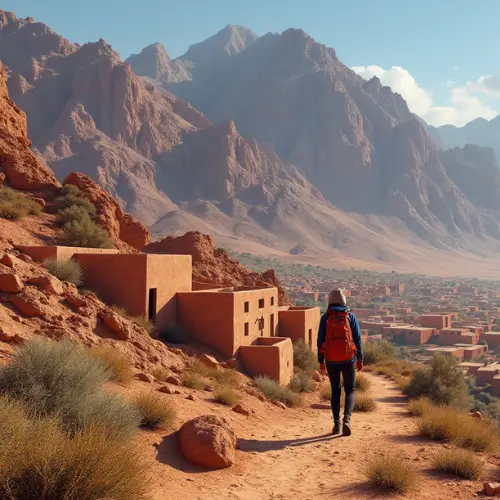
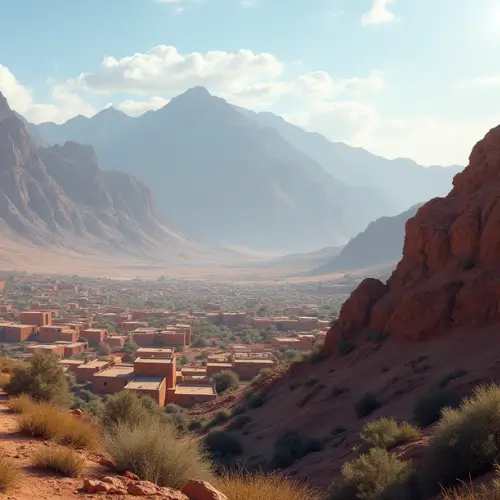
- Begin your trek early (7:00 AM) from Imlil to Toubkal Refuge
- Follow the well-marked path through Aremd village and the shrine of Sidi Chamharouch
- The trek covers approximately 6.8 miles with 4,600 feet of elevation gain
- Arrive at the refuge by mid-afternoon (typical hiking time: 5-7 hours)
- Rest, hydrate, and prepare equipment for the summit attempt
- Share a communal dinner with fellow trekkers at the refuge
Pro tip: Pack toilet paper and hand sanitizer, as facilities along the route are basic at best.
Day 4: Summit Day & Descent to Imlil
- Begin the summit attempt before sunrise (around 5:00 AM)
- Follow the southern col route to Toubkal’s summit (approximately 3-4 hours up)
- Spend 30-45 minutes enjoying the breathtaking panoramic views
- Descend to the refuge for a quick lunch and rest
- Continue descending to Imlil (approximately 4-5 hours from refuge)
- Celebrate your achievement with a hammam (traditional bath) in Imlil
Pro tip: Use trekking poles for the descent to reduce impact on your knees; the terrain is loose scree in many sections.
Day 5: Ourika Valley Day Trip
- Arrange a driver to explore the Ourika Valley (approximately 600-700 dirhams for the day)
- Visit the Setti Fatma waterfalls in the morning (before crowds arrive)
- Stop at a women’s argan oil cooperative to learn about this local product
- Enjoy lunch at a riverside restaurant
- Explore several Berber villages in the afternoon
- Return to Imlil by evening
Pro tip: Wear water shoes or sandals with good grip for exploring the waterfalls safely.
Day 6: Transfer to Ait Ben Haddou
- Take shared transport or hire a private driver to cross the mountains to Ait Ben Haddou (approximately 4-5 hours)
- Check into a traditional kasbah-style accommodation
- Explore the ancient ksar in late afternoon light (ideal for photography)
- Enjoy dinner on a terrace overlooking the UNESCO site
Pro tip: Most guided tours arrive at Ait Ben Haddou between 11:00 AM and 2:00 PM, so plan your exploration outside these hours.
Day 7: Return to Marrakech & Departure
- Visit Ait Ben Haddou at sunrise before other visitors arrive
- Return to Marrakech via Tizi n’Tichka pass (approximately 4 hours)
- Allow time for stops at panoramic viewpoints along this scenic mountain route
- Arrive in Marrakech with time for last-minute shopping or relaxation before departure
Pro tip: The Tizi n’Tichka pass reaches 7,415 feet elevation and can be foggy; if weather is poor, consider the longer but lower-elevation route through Agadir.
Budget Breakdown
Planning your finances effectively will ensure a smooth journey through the Atlas Mountains. Here’s a comprehensive breakdown of costs to expect:
Accommodation
- Budget Option: Shared rooms in mountain gîtes or refuges (70-150 dirhams per night)
- Mid-range Option: Private rooms in family-run guesthouses (200-400 dirhams per night)
- Premium Option: Boutique kasbahs or mountain lodges (600-1,500 dirhams per night)
Weekly Average: 1,400-2,800 dirhams ($140-280) for mid-range accommodations
Food
- Breakfast: Typically included with accommodation, otherwise 20-40 dirhams
- Lunch: Simple mountain meals or packed lunch (30-70 dirhams)
- Dinner: Traditional tagine or couscous meals (60-150 dirhams)
- Drinks: Mint tea (10 dirhams), bottled water (5-10 dirhams per 1.5L)
Daily Average: 120-250 dirhams ($12-25) for meals and drinks
Activities
- Mountain Guide: 400-500 dirhams per day (highly recommended for technical routes)
- Equipment Rental: Ice axe and crampons in winter (100 dirhams per day)
- Cultural Experiences: Cooking classes (300-400 dirhams), traditional music performances (100-200 dirhams)
- Site Entrance Fees: Most natural sites are free, but cultural sites like kasbahs charge 20-50 dirhams
Weekly Average: 1,000-2,500 dirhams ($100-250) depending on activities chosen
Transportation
- Marrakech to Imlil: Shared grand taxi (70-100 dirhams per person) or private transfer (600-800 dirhams)
- Mountain Village to Village: Shared transit where available (30-70 dirhams) or hiking
- Cross-Mountain Transfers: 700-1,200 dirhams for private vehicle
- Local Mule Transport: 150-200 dirhams per day for luggage transport on trails
Weekly Average: 1,000-2,500 dirhams ($100-250) depending on chosen transport methods
Total Budget Range (7 days)
- Budget Traveler: 3,500-5,000 dirhams ($350-500)
- Mid-range Traveler: 5,500-8,000 dirhams ($550-800)
- Luxury Traveler: 10,000-20,000 dirhams ($1,000-2,000)
Money-Saving Tip: Many mountain guesthouses offer package deals including accommodation, meals, and guided hikes at a discount of approximately 20% compared to paying separately.
Travel Tips for a Seamless Experience
Solo Safety Strategies
Solo travel in the Atlas Mountains is generally safe, but smart precautions enhance your experience:
- Register your trekking plans with your accommodation
- Consider hiring a local guide for remote areas (they provide cultural insights beyond safety)
- Carry a basic first aid kit and know how to use it
- Download offline maps and carry a physical map as backup
- Invest in a satellite messenger device if trekking remote areas
Language Navigation
Berber (Amazigh), Arabic, and French are the primary languages in the region:
- Learn basic greetings in Berber (“Azul” = Hello, “Tanemmirt” = Thank you)
- Download a French-English translation app with offline capabilities
- Carry a small notebook for drawing or writing numbers during negotiations
- Practice the international hand signal for “How much?” (rubbing thumb against fingers)
Cultural Respect
Respecting local customs enriches your journey:
- Dress modestly, especially when visiting villages (shoulders and knees covered)
- Ask permission before photographing people
- Remove shoes when entering homes or religious buildings
- Use your right hand for eating and greeting
- Accept offered mint tea when possible—it’s considered rude to refuse this gesture of hospitality
Connectivity Considerations
Plan for limited digital connectivity:
- Inform important contacts of your general itinerary before entering remote areas
- Purchase a Moroccan SIM card in Marrakech (Maroc Telecom has the best mountain coverage)
- Download entertainment, maps, and translation resources before departure
- Bring a portable power bank with sufficient capacity for your entire trek
Responsible Tourism
Practice sustainable travel in this fragile mountain ecosystem:
- Carry all trash until proper disposal is available
- Support community-based tourism initiatives like locally-run guesthouses
- Conserve water, which is precious in mountain villages
- Consider carbon offsetting your journey
- Purchase locally-made crafts directly from artisans
Local Cuisine and Dining Suggestions
The Atlas Mountains offer unique culinary experiences that differ from Morocco’s urban centers, with dishes adapted to the mountain climate and available ingredients.
Must-Try Mountain Dishes
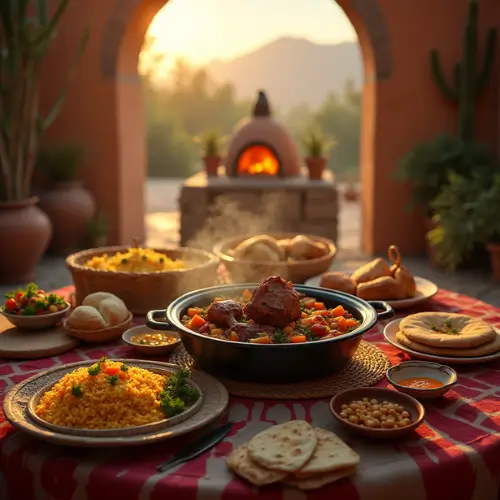

Tagine Berber Style
Unlike city versions, mountain tagines feature simpler ingredients with distinctive herbs like wild thyme and sage. The slow-cooking process in earthenware pots infuses meat (typically lamb or chicken) with complex flavors. For the most authentic experience, try tagine at a family home in Imlil or Aremd village.
Mechoui
This slow-roasted lamb is prepared in communal earth ovens in larger villages. The meat becomes incredibly tender after hours of cooking, with a smoky flavor that pairs perfectly with fresh-baked bread. Best experienced during local festivals or arranged through your guesthouse host.
Couscous Beldi
Hand-rolled traditional couscous made from local grains, typically served on Fridays. Mountain versions include seasonal vegetables like turnips, pumpkin, and carrots. Visit a local home in the Ourika Valley for the most authentic version, where families still hand-roll their couscous.
Aghrum n’Igran
Traditional Berber flatbread baked on clay or stone surfaces, often incorporating barley and served with mountain honey and olive oil. Best experienced fresh from community ovens in villages like Tizi Oussem.
Tanorte
A hearty mountain soup made with legumes, vegetables, and sometimes meat, perfect for cold evenings. The Toubkal Refuge serves a particularly good version to refuel trekkers.
Dining Recommendations
Earth Lodge (Imlil)
This eco-friendly establishment serves organic vegetables from their garden alongside traditional recipes with modern presentations. Their terrace offers stunning views of surrounding peaks.
Kasbah du Toubkal Restaurant
Though pricier than other options, their locally-sourced menu supports sustainable farming practices while offering refined versions of traditional dishes.
Chez Ibrahim (Aroumd Village)
A family-run establishment where Ibrahim prepares dishes using hereditary recipes passed down through generations. Their walnut tagine is exceptional.
Café Aladdin (Ait Ben Haddou)
Perfect for lunch after exploring the ancient ksar, offering panoramic views and traditional meals with veget

